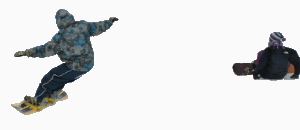Snowboarding is a winter sport that involves descending a slope that is covered with snow while standing on a board attached to a rider's feet, using a special boot set onto a mounted binding. The development of snowboarding was inspired by skateboarding, sledding, surfing and skiing.
Since snowboarding's inception as an established winter sport, it has developed various styles, each with its own specialized equipment and technique. The most common styles today are: freeride, freestyle, and freecarve/race. These styles are used for both recreational and professional snowboarding.

Snowboarding is popular in many places most commonly the following countries:
| Austria | Canada | Finland |
| France | United States of America | Switzerland |
Alpine Snowboarding
Sometimes called freecarving, this takes place on hard packed snow or groomed runs and focuses on carving linked turns, much like surfing or longboarding. Alpine Snowboarding consists of a small portion of the general snowboard population that has a well connected social community and its own specific board manufacturers. Alpine Snowboard equipment is a ski-like hardshell boot and plate binding system with a true directional snowboard that is stiffer and narrower to manage linking turns with greater forces and speed.
Risks of Snowboarding
The injury rate for snowboarding is about four to six per thousand persons per day, this is around double the injury rate for alpine skiing. Injuries are more likely amongst beginners, especially those who do not take lessons with professional instructors
| Broken Bones | Concussion | Dislocated Shoulders | Fractures |
| Impact Injures | Neck Injures | Sprains | Torn Ligaments |
Beginners at the sport are likely to find that they come away with more than a few bruises after their first few attempts. The way in which a person is strapped to the snowboard means that it is relatively easy to sustain more serious injuries, should any kind of accident or collision occur.
So is it really worth the risk to have no guarantee, no safety net for you to fall into if the worst case scenario occurs?
By insuring yourself, before departing on what is hopefully to be an enjoyable holiday, you can be covered up to £25,000 for loss of limbs, click here for more information on our wintersports travel insurance.
In addition you can be covered for delayed or missed flights and even up to £10,000,000 for repatriation.
Nobody wants to be in a foreign hospital thousands of miles away from their family when they’re injured or ill!
Another perilous risk of snowboarding would be the unavoidable case of an avalanche. Avalanches kill over 150 people worldwide each year and force piste closures in every ski resort around the world, sometimes for days at a time. No one wants to pay for a skiing holiday then be unable to snowboard due to weather conditions which result in sudden avalanches!
So, here at cover4travel, we feel it’s only right you receive £100 after a full 12hour delay resultant of an avalanche. It is always advisable to be covered for any case of disaster, be it injury, airline failure, baggage delay or even holiday abandonment! Nobody knows what events may happen in the future so wouldn’t you rather be prepared for any form of catastrophe which may arise?! Plan ahead, be prepared, and get insured.